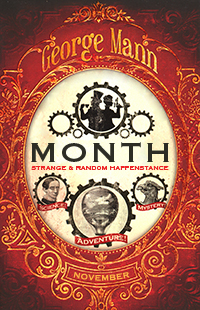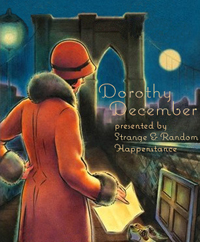Book Review - Lauren Willig's The Girl from Greenwich Street
 The Girl from Greenwich Street by Lauren Willig
The Girl from Greenwich Street by Lauren Willig
Published by: William Morrow and Company
Publication Date: March 4th, 2025
Format: Hardcover, 352 Pages
Rating: ★★★★
To Buy
Elma Sands was the unfortunate relation who no one wanted, shunted between relatives and born in shame. For two years she had been living with her cousin Caty Ring, a good Quaker, who ran a boardinghouse and millinery at 208 Greenwich Street. On December 22, 1799, Elma was giddy, trying to decide which kerchief suited her best, never mind that one belonged to Peggy, who worked in the millinery. That night when Elma left the house on Greenwich Street she thought it was for a better life. Because her rendezvous at Lispenard's Meadow was the first stop on the way to the church, because she meant to be married that night! Well, the second stop, after she went next door to borrow Beth's muff. A muff that would be found two days later near the Manhattan Well. Her body was recovered from that very well on Thursday, January 2nd, 1800. Everyone assumed that the "groom" had to be responsible for Elma's death and the blame landed on Elma's supposed beau, Levi Weeks, who was arrested. The arrival of Levi Weeks at the Ring's boardinghouse was the first of several momentous events in Elma's life in 1799 that culminated in her death. The second was an outbreak of yellow fever which sent Caty and her children to the country and left Elma in charge of the boardinghouse. The third was Elma becoming ill and her cousin refusing to send for a doctor. Speculation being that Elma miscarried. Which begs the question, who was the father? And could this man also have been her killer? While Levi Weeks was nothing more than a carpenter, his brother, Ezra Weeks, who laid the pipes for the Manhattan Well, was one of the most sought-after builders in the city and was going to make sure his brother's defense was the best. To that extent he retained Henry Brockholst Livingston and Aaron Burr as defense attorneys. And then Alexander Hamilton offered himself up as part of the defense. Hamilton personally knew that it wasn't enough to create doubt, one must leave no doubt when a man's honor is at stake, and possibly another man's dream home. Because Hamilton desperately wanted Ezra Weeks to build him a house and when he exonerated Levi that dream would become a reality, and thwarting Burr was just an added bonus. When the trial began on March 31st Hamilton brought the drama and Burr brought his methodical destruction of the prosecution's evidence, point by point. They were often at odds in their defense of Levi, but at the end of the unheard of two day trial history would be written with the verdict for the first recorded murder trial in the United States.
This is the book that Lauren was born to write with her background in law, history, and historical fiction. She brought to life a murder trial, which, while sensational, could have felt too much like a weighty tome read for a history class if not handled this deftly. She has done what few are able to do in true crime and historical fiction, I felt that all the people were real, not just mechanisms to solve an unsolved mystery. Elma wasn't just a victim, as Lauren has Alexander discover when looking into the case. You get a sense of Elma, the forceful young lady who was restless and unable to break out of her circumstances. Trapped by religion, family, and sex, she has been lost to history as just the victim and not remembered as a complicated woman. And who she was was informed by who she lived with and the day to day life of Caty and Elias Ring's boardinghouse adds that extra human dimension that is so necessary to really connect to history. What's more, she captured the city of New York in 1800. I felt like it was it's own character, and I kept thinking that in that regard it reminded me of The Alienist. The city was alive and had a pulsing heart and it just swallowed up Elma whole. I almost felt as if the city killed her more than any one real person. Lauren also hones in on weird details that make everything feel more real. Like the Manhattan Well project thought that wood would work well for pipes. Wood. And I'm not talking about the kind you smoke. And yes, I get that this did happen going back in history, I just feel that by 1800 they should have known better. But it's not just the weird little quirks of the city that Lauren captures, but weird shifts in law that we, used to watching Law and Order and a million other procedural shows, might not know. Like Levi Weeks couldn't take the stand in his own defense. That. That is just wild. I mean. I feel like that is the basis of a defense case and yet they were not allowed to use it. Also the fact that two days for a murder trial was unheard of. Were they just looking for the jury to convict or acquit quickly because they wanted to go home? And yes, there were murder trials before this one, despite what some reviewers would have you believe, this is the first recorded murder trial, and by recorded, that means we have a transcript thanks to William Coleman, who himself had a storied life. But speaking of the most storied lives, Burr and Hamilton. Because of Lin-Maniel Miranda's musical we have a kind of propitiatory air when it comes to these two. Lauren taps into that but also you feel that they're real people. Not just people dancing and singing to entertain, but putting on a show to free a man. If this book has one fault it's that seeing as this is historical fiction I felt that Lauren would have been justified to take the extra step and say straight-out that Caty Ring's boarder Richard Croucher was the real killer. Perhaps the historian in her wouldn't let her do that except in the "Historical Note." For me though, I think I needed it. I needed that moment of Elma facing Richard at the well. I needed the story to come full circle back to her.





















































































Post a Comment